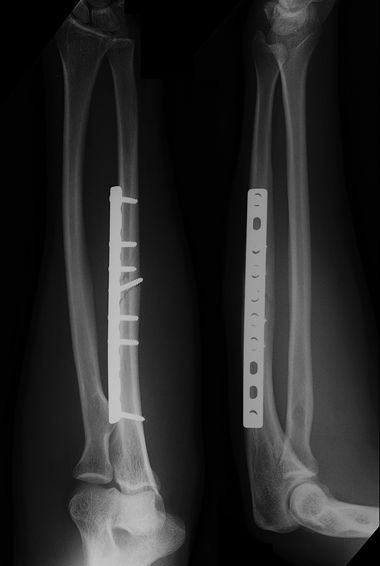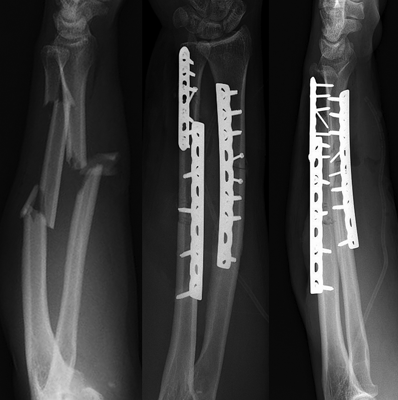Sterile Instruments/Equipment
- 3.5-mm compression plates with 3.5-mm cortical screws
- 2.7-mm plates, especially for distal ulnar diaphyseal fractures
- 2.0- and 2.4-mm screws
- On-table plate bending press or hand-held bender and torquing irons
- Small pointed bone reduction clamps
- Small serrated bone reduction clamps
- K-wires and wire driver/drill
Patient Positioning
- Supine position with a radiolucent arm table.
- May use proximal arm tourniquet, if desired.
- Surgeon is usually seated in the patient’s axilla.
Surgical Approaches
- Ulna: direct approach to subcutaneous border of ulna, use interval between ECU and FCU.
- If the ECU or FCU has been traumatically disrupted, continue elevation of this muscle to avoid plating directly on the subcutaneous ulnar ridge.
- Plate may be placed on the volar surface (under FCU), on the dorsal surface (under ECU), or directly on the subcutaneous border of ulna.
- The ideal location should depend primarily on the fracture morphology.
- If the ECU or FCU has been traumatically disrupted, continue elevation of this muscle to avoid plating directly on the subcutaneous ulnar ridge.
- Radius: Volar Henry approach for exposure of the radius.
- Allows extensile exposure from proximal to distal radial shaft.
- Retract radial artery ulnarly.
- Alternatively, through sheath and bed of FCR tendon, then retract radial artery radially.
- Allows extensile exposure from proximal to distal radial shaft.
Reduction and Fixation Techniques
- For both bone forearm fractures, usually approach and reduce the fracture with the simpler pattern first.
- Restores length of the forearm anatomically.
- This facilitates anatomic reduction with the other bone and subsequently facilitates reduction of the more complex fracture.
- Restores length of the forearm anatomically.
- Multiple independent 2.0- or 2.4-mm lag screws are useful for fractures with comminution (e.g., butterfly, segmental). After interfragmentary lag screw fixation, a neutralization plate is applied spanning the area of injury.
- Usually place plates on the volar surface of the ulna (under FCU, in the flexor compartment) to avoid implant irritation as patients rest their forearms on their direct ulnar border.
- However, if either extensor carpi ulnaris or the flexor carpi ulnaris is stripped/disrupted more than the other, this muscle should be elevated preferentially.
- The plate should be placed under the elevated muscle, preserving the soft tissue attachments and hence, the blood supply of the intact muscle (Fig. 8-1).
- However, if either extensor carpi ulnaris or the flexor carpi ulnaris is stripped/disrupted more than the other, this muscle should be elevated preferentially.

Figure 8-1. Ulnar plate placed on the flexor surface.
![]()
- For distal one-fourth ulnar fractures, consider a 2.7- or 2.4-mm compression or locking plate, especially for individuals of small stature or with osteoporosis.
- Hole spacing of the plate will allow more points of fixation in a short distal segment.
- Additionally, a 2.7-mm plate may have a better coronal plane fit than a 3.5-mm plate (Fig. 8-2).
- Hole spacing of the plate will allow more points of fixation in a short distal segment.
Figure 8-2. A segmentally comminuted ulnar fracture stabilized with two plates. A smaller plate was used for distal ulnar shaft fracture as it permitted fixation with more screws and offered a lower profile plate fit.
![]()
- Once length and stable fixation is obtained in one bone, the wound should be closed prior to performing the second approach to the other forearm bone.
- In acute trauma, generally only the skin and subcutaneous tissues are closed over the plate, to avoid compartmental syndrome.
- However, in subacute fractures, consideration may be given to closing the fascia of the FCU to the fascia of the ECU over the border of the ulna.

Stay updated, free articles. Join our Telegram channel
- In acute trauma, generally only the skin and subcutaneous tissues are closed over the plate, to avoid compartmental syndrome.

Full access? Get Clinical Tree






